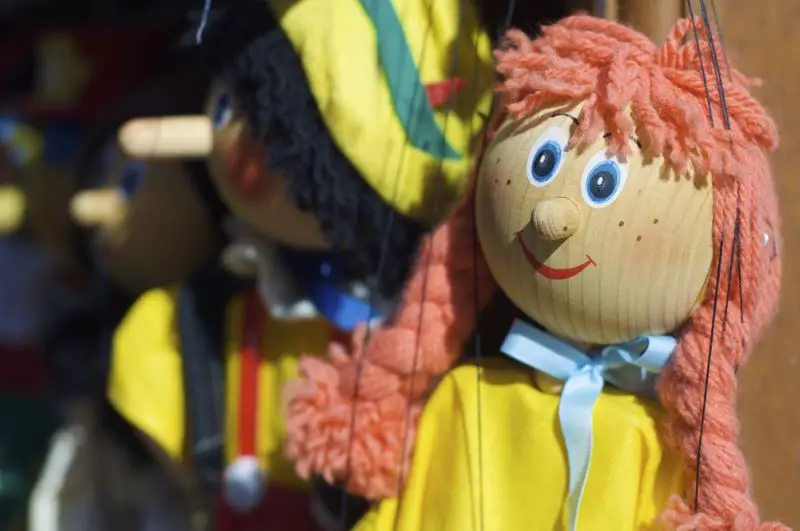Click here to get this post in PDF
Puppetry is an ancient form of storytelling that transcends cultures, bringing history, myth, and imagination to life through intricate craftsmanship and skilled manipulation. From the mesmerising shadow puppets of Indonesia to the complex, life-sized Bunraku puppets of Japan, the art of puppetry offers a unique glimpse into the soul of different societies. In this post, we will take a deep dive into the cultural variations of puppet art across the globe, exploring how different regions have embraced and developed this timeless art form.
Japanese Bunraku: The Art of Subtlety and Precision
Japan’s Bunraku puppetry stands out as one of the most sophisticated forms of puppetry in the world. Originating in the early 17th century, Bunraku is a highly stylised puppet theatre where life-sized puppets are controlled by up to three puppeteers at a time. These puppeteers, dressed in black to signify their invisibility, must work in perfect harmony to bring each puppet to life with fluid, delicate movements.
Bunraku performances are often accompanied by a tayu (narrator) and shamisen (a traditional three-stringed instrument), adding depth and emotion to the stories being told. The plays often revolve around tragic love stories, samurai tales, or historical events, allowing audiences to connect with the characters on an emotional level.
What sets Bunraku apart is its intricate attention to detail. The main puppeteer controls the puppet’s head and right hand, while the two other puppeteers handle the left hand and feet, respectively. This meticulous coordination brings out incredibly lifelike gestures, capturing the audience’s imagination. It’s a delicate balance of movement, music, and storytelling that makes Bunraku a true spectacle of Japanese culture.
Indonesian Wayang: Shadow Puppetry Steeped in Tradition
Indonesia’s Wayang puppetry is deeply rooted in the country’s spiritual and cultural traditions. The term “Wayang” refers to both the puppets and the performance itself. These shadow puppets, typically made from intricately carved leather, are brought to life behind a translucent screen by a skilled puppeteer, known as a dalang. The dalang manipulates the puppets using rods, casting shadows on the screen while narrating stories from ancient epics like the Mahabharata and Ramayana.
The stories told through Wayang performances are not only for entertainment but often carry moral and philosophical lessons, drawing from Hindu, Buddhist, and local Indonesian beliefs. The puppet show is accompanied by traditional gamelan music, adding an ethereal atmosphere to the performance.
What makes Wayang fascinating is the role of the dalang, who not only controls the puppets but also acts as the narrator, voice actor, and conductor of the orchestra. The dalang is revered as a spiritual figure, as the art form is believed to connect the physical and spiritual realms. In rural communities, Wayang performances are still integral to religious festivals and ceremonies, preserving a tradition that dates back over a thousand years.
Italian Marionettes: The Elegance of String Puppetry
Italy has long been associated with marionette puppetry, a form of puppetry that uses strings to control delicate wooden figures. Italian marionettes reached their height of popularity in the 18th century, captivating audiences with their ability to perform complex and graceful movements. Unlike shadow or hand puppetry, marionettes are known for their elegance and the skilled artistry required to control them.
One of the most iconic Italian puppetry traditions is the Opera dei Pupi, which originated in Sicily in the early 19th century. These marionette shows are grand in scale and often depict scenes from medieval knightly epics, such as the tales of Charlemagne and his paladins. The marionettes used in these performances are intricately crafted, with detailed armour and lifelike expressions.
The puparo (puppeteer) expertly controls the marionettes, using strings to manipulate their limbs and heads, creating lifelike gestures and combat scenes. Opera dei Pupi remains a cultural treasure in Sicily, and efforts to preserve and revitalise this art form have led to its recognition as a UNESCO Intangible Cultural Heritage.
Puppetry as a Universal Art Form
Despite the cultural differences in how puppetry is practised across the world, one thing remains constant: puppetry is a powerful medium for storytelling, capable of evoking deep emotions, conveying complex narratives, and bridging cultural gaps. Whether it’s the precision of Japanese Bunraku, the spiritual essence of Indonesian Wayang, or the elegance of Italian marionettes, puppetry reflects the values, history, and creativity of the societies that practise it.
For those looking to explore this fascinating art form further, there are many ways to experience puppetry today, from live performances to creating your own puppet shows. If you’re interested in acquiring your own set of beautifully crafted puppets for storytelling or display, you can find a wide selection of high-quality puppets here.
Puppetry is a captivating art form that has been embraced by cultures all around the globe, each adding its unique flair and meaning to the practice.
Whether you’re fascinated by the elaborate Bunraku puppets of Japan, the mystical shadow puppets of Indonesia, or the enchanting marionettes of Italy, the world of puppetry offers endless opportunities for exploration and wonder.
By diving into the rich traditions of puppetry from different cultures, we gain insight not only into the art itself but also into the societies that continue to keep this ancient craft alive. So next time you see a puppet show, remember – you’re not just witnessing a performance; you’re engaging with centuries of cultural history, imagination, and storytelling.
You may also like: Important Cultural Tips For Expats Living In Thailand
Image source: DepositPhotos.com

